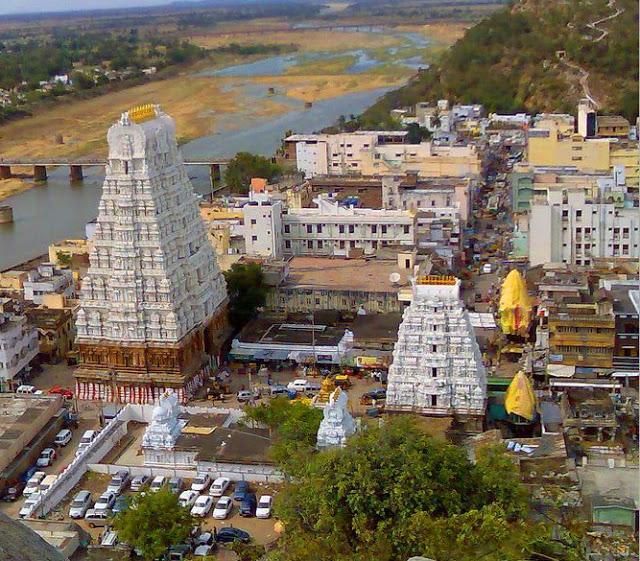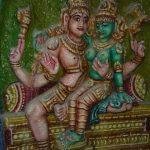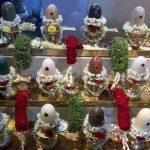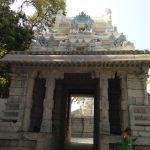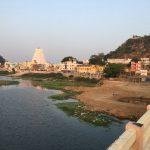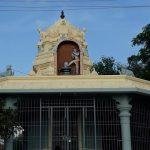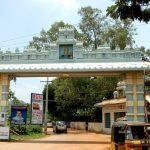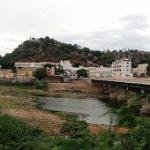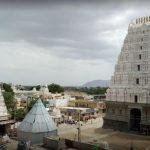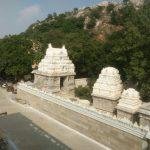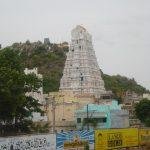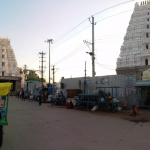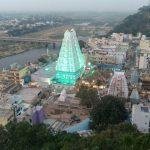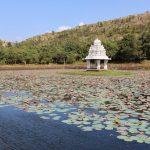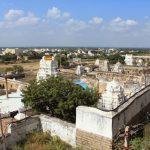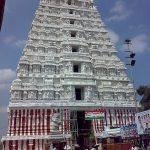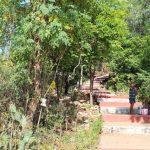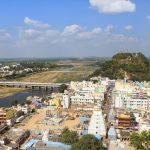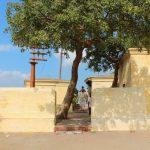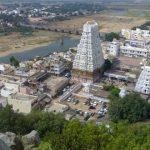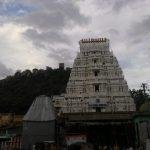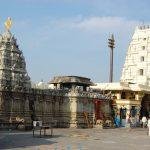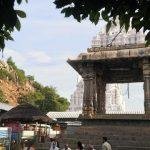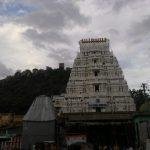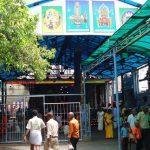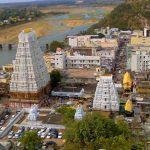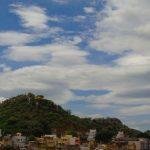Kalahasteeswara Swamy Temple, Sri Kalahasthi, Andhra Pradesh
| Date built: | – |
|---|---|
| Deity: | Kalahasteeswara Swamy |
| Architectural style: | Dravidian architecture |
| Major festivals | – |
| Locale: | Sri Kalahasthi |
| District:: | Chittoor |
| Address: | Kalahasteeswara Swamy Temple,Sri Kalahasti, Chittoor District, Andhra Pradesh – 517644 |
| Phone | +91 8578 222240 / 221336 /+91 9885974050 |
Vayu is incarnated as Lord Shiva and worshipped as Kalahasteeswara. Goddess Parvathi Devi is worshiped here as Gnanaparasunambikai. It is one of the most famous Shiva temples in South India, and is said to be the site where Kannappa, one of the 63 Saivite Nayanmars, was ready to offer both his eyes to cover blood flowing from the Siva Linga before the Lord Siva stopped him and granted him Mukthi. The inner temple was constructed around 5th century and the outer temple was constructed in the 12th century by the Chola Kings and the Vijaya Nagara kings.
The Shivalinga at Sri Kalahasti is marked by symbols of three creatures — that of a spider at the bottom, a five-hooded snake on top and elephant-tusks on either side. Legend informs us that Sri (spider), Kala (snake) and Hasti (elephant) were cursed by Brahma, Shiva and Parvati but attained moksha by worshipping Lord Shiva here. Hence Shiva came to be called Sri Kalahasteeswara. It is one of the shrines of the 275 Paadal Petra Sthalams – Shiva Sthalams glorified in the early medieval Thevaram poems by Tamil Saivite Nayanar Sundarar.
This is one of the 276 Devara Paadal Petra Shiva Sthalams and 19th Shiva Sthalam in Thondai Nadu. A lamp burns inside the inner sanctum that constantly flickers despite the lack of air movement inside. Kalahasti is located near the pilgrimage town of Tirupati and is visited by thousands of pilgrims. The river Swarnamukhi takes the northerly course at Sri Kalahasthi almost washing the west wall of the famous Sri Kalahasthi temple. The temple architecture is a treat to the eyes for all those who visit Srikalahasthi.
Temple Opening Time
The temple remains open from 5.00 a.m. to 12.00 a.m. and 5.00 p.m. to 9.00 p.m.
Prayers
Thousands of pilgrims visit this temple to have darshan of the almighty Sri Kalahasteeswara and Sri Gnanaparasunambikai Devi. Sri Kalahasteeswara showers grace to wipe out the sins and obstacles of devotees. Worshipping Sri Kalahasteeswara results in dispelling all worldly miseries and attaining marvelous spiritual happiness. Goddess Gnanaparasunambikai Devi received the Panchakshara mantra from the Lord himself. The Goddess arrived at the place and started her penance here.
Of the nine planets, Kalahasthi importance is attached to Rahu and Ketu (Dragon’s tail and head respectively) those afflicted with the adverse effects of these planets and problems related to snakes, pray for relief here. After fulfillment of the prayers, devotees perform Abhishek to the Lord, offer Vastras (clothes) and also offer donation for the maintenance of the temple depending on their affordability.
Shri Kalahasteeswara Swamy temple is reputed as the Rahu Kethu Kshetra. People who have Rahu Kethu Doshas and Sarpa Doshas, the unmarried, those with children and those who are facing various problems for long period, perform the most effective Rahu – Kethu Sarpa Dosha Nivarana pooja in this temple all, it is believed that the Doshas get removed and desired results occur. Thousands of devotees from the country and abroad perform this pooja and fulfill their vows continuously, after receiving good results.
Festivals
The temple follows Saivite tradition. The temple priests perform the pooja (rituals) during festivals and on a daily basis. The temple rituals are performed four times a day: Kalasanthi at 6:00 a.m., Uchikalam at 11:00 a.m., Sayarakshai at 5:00 p.m and Sayarakshai between 7:45 – 8:00 p.m. Each ritual has three steps: Alankaram (decoration), neivedhyam (food offering) and Deepa aradhanai (waving of lamps) for both Srikalahasteeswara and Gnana Prasunambika. There are weekly, monthly and fortnightly rituals performed in the temple. The temple is open from 6am – 12 pm and 4-8:30 pm.
Kalahasthi temple is closely attached with the history of Kannappar, whose bhakti (devotion) is yet to be equaled in the history of the religious literature of Tamilnadu. Acharya Shankara had devoted a verse in praise of Kannappar in his celebrated Shivanandalahari. Sekkizhar, in his Periyapuranam elaborately sings the greatness of Kannappar in 185 verses. Kannappar performed abishek to the Lord bringing water from the Swarnamukhi river in his mouth. Vibhuti Prasad is not offered in this temple, but symbolizing the Abishek Theertha of Kannappar, only Theertha Prasad (water) is offered to the devotees mixed with Pachai Karpooram. It is offered through a conch.
The Vibhuti (sacred ash) brought by the devotees are placed at the feet of the Lord, an Arati is offered and returned to the devotee. Abishek is performed to the Lord only with water mixed with Pachai Karpooram. Other Abisheks are offered only to the stage (called Avudayar – the Linga Peetam). As the Shrine is related to Rahu-Ketu planets, devotees do the Pradikshina in an anti-clockwise way. As sage Bharadhwaja performed penance here, only those belonging to the Bharadhwaja Gotra are appointed as archakas in the temple.
The Kavacham covering the Lord has the symbols of the planets, hence there is no separate shrine for the Navagrahas except for Saturn. Garlands are not offered on the body of Lord. An Angi – upper cloth – is placed on the Lord on which Thumba Flower Garland is placed. In the Oddiyanam (belt made of gold studded with pearls and precious stones), of Mother Gnanaparasunambikai, the symbol of planet Kethu is carved. There is a temple for Lord Manikandeswarar on the slopes of the hill through which Kannappar went on the hill taking his Abishek Water from Ponmuhali river.
There is also a mandap called Manikarnika Gattam near this temple carved out of the hill. The story goes that it is here Lord Shiva uttered the Tharaka Mantra to a woman (commonly known as Karna Manthra being uttered on the ears of the departing soul) as Lord Viswanatha did in Kasi – Varanasi to a devotee. Following this tradition, devotees use to bring those nearing their end to Manikarnika Gattam and place them lying here so that the last breath may leave the mortal body through the right ear. Procession of Lord is taken from the North tower entrance. As Maharishis worshipped the Lord facing the east after a dip in the Ponmuhali river, Lord Kalathiappar is facing west to bless the Rishis.
Maha Shivaratri is the most important festival when lakhs of devotees offer prayers to seek the blessings of the Lord. Mahasivarathri Brahmotsavams are celebrated in par with Maha Shivaratri for 13 days during which the Utsava Murtis of Siva and Parvati will be taken on Vahanams in a procession around the temple streets. The fifth day of the festival in the month of Maasi coincides with the Maha Shivaratri. Mahasivarathri, Nandi Seva, Lingodbhavam, Rathotsavam, Theppotsavam and Swami-Ammavarla Kalyanotsavam are the important aspects of this festival. Shivaratri, Vinayaka Chaturthi, Vijayadasami, Thirukarthigai in November-December, Oonjal festival on all Fridays, Makara Sankaranthi (Pongal) in January and Giri Valam on Shivarathri day are the other important festivals celebrated here.
Pooja Timings
| S. No | Poojas | Timings |
| 1 | Suprabatham | 5-30 AM |
| 2 | Sarvadarshanam | 6-00 AM |
| 3 | Pradhama Kala Abishekam | 7-30 AM |
| 4 | Dwthiya Kala Abishekam | 9-00 AM |
| 5 | Ucchi kala Abishekam | 10-30 AM |
| 6 | Rudhra Homam | 11-00 AM |
| 7 | Chandhi Homam | 11-00 AM |
| 8 | Nityothsavam | 11-00 AM |
| 9 | Nithya Kalyanam | 11-30 AM |
| 10 | Pradhosha Kala Abishekam | 5-30 PM |
| 11 | Niranjana Manthra Pushpam | 7-00 PM |
| 12 | Ekantha Seva | 9-00 PM |
| 13 | Temple Closing Time | 9-00 PM (every day)
9-30 PM (on Saturday to Monday) |
Architecture
Legend / Local stories
Srikalahasthi:
Srikalahasthi is named after Sri (spider) Kala (Snake) Hasti (Elephant). They were staunch devotees of Lord Shiva. According to Hindu mythology, the elephant or Hasti used to clean the Shiva deity by watering the idol with the help of river-water carried in his trunks and pray for him by placing Vilva leaves. The spider or Sri tried to protect the deity from external damage by weaving his web and to provide shelter for the Shiva lingam. The snake or Kala used to place its precious gem on the Linga to adorn the lord. In this way, they all worshipped the Vayu Linga separately without knowing what the other was doing.
One day, the spider had built a very big and thick web around the deity to protect it from dust and weather while the snake places its gem. The elephant not knowing this and assuming that this form of puja by Sri and Kala is a desecration by the seeming miscreants, pours water on it and cleans it up. This causes a war between the three. The snake punishes the elephant by entering its trunk and in the process, kills itself while the elephant runs amok and hits its trunk and head against the Shiva Linga.
During this struggle, the spider is squashed against the Linga by the elephant’s trunk and the elephant dies due to the snake’s poison. Lord Shiva then appeared and gave moksha to all three of them for their selfless devotion. The spider takes rebirth as a great king while the elephant and the snake reaches heaven for satisfying all its karma. This king continues his good work from his previous birth and builds a variety of temples that seeks to protect the underlying deity with tons of stones.
It is interesting to note that all his temples, keep the deity beyond the access of an elephant. In this temple, access to the deity is through a narrow passage in the side of the building that prevents an elephant from extending its trunk over the lord from any side. This temple is considered as the Kailash of the South or Dakshina Kailasam. At the foot of the Linga one can see a spider, two elephant tusks and a five-headed (the five elements) serpent to remind the devotee of these acts of supreme devotion. The legend here is similar to that of the Jambukeswarar temple at Tiruvanaikkaa.
Vayu Lingam:
During the early days of creation, Lord Vayu performed penance for thousands of years to “Karpoora Lingam” (Karpooram means camphor). Pleased with his penance, Lord Shiva manifested before him and said, ” O Vayu Deva! Though you are dynamic in nature, you stayed here without movement and did penance for me. I’m pleased with your devotion. I shall grant you three boons”. Lord Vayu said, “Swami! I want to be present everywhere in this world. I want to be an integral part of every Jiva who is none other than the manifestation of Paramatma. I want to name this Karpoora Linga, which represents you, after me.
Samba Siva said,” You are qualified for these three boons. As per your wish, you will be spread throughout this world. Without you there will be no life. This Linga of mine will forever be known all over through your name, and all Suras, Asuras, Garuda, Gandharvas, Kinnaras, Kimpurushas, Siddhas, Saadhvis, humans and others will worship this Lingam”. Lord Shiva disappeared after granting these boons. Thereafter, this Karpoora Vayu Lingam is worshipped by all Lokas (worlds).
Gnana Prasunambika Devi:
Once, Parvati was cursed by Lord Shiva to discard her heavenly body and assume the human form. To get rid of the above curse Parvati did a long penance here. Pleased with her deep devotion Lord Shiva again recreated her body – a hundred times better than her previous heavenly body and initiated various mantras including the Panchakshari. Consequent to this, Parvati gained fame and came to be known as Shiva-Gnanam Gnana Prasunamba or Gnana Prasunambika Devi.
Ghanakala prayed to Lord Shiva here:
Cursed to become a ghost, Ghanakala prayed at Srikalahasthi for 15 years and after chanting the Bhairava Mantra many times Lord Shiva restored her original form.
Mayura, Chandra and Devendra prayed to Lord Shiva here:
Mayura, Chandra and Devendra were also freed from their curses after taking bath in the river Swarnamukhi and praying at Srikalahasthi.
Lord Shiva preached to Sage Markandeya here:
To Markandeya, Lord Shiva appeared in Srikalahasthi and preached that a Guru alone could make esoteric teachings and, therefore he is Brahma, Vishnu and Maheswara.
Legends of Kannappa Nayanar:
Kannappa Nayanar was an enthusiastic devotee of Lord Shiva and a hunter by profession. It is believed that once, he saw blood coming out of the eyes of the Lord Shiva. Kannappa plucked out one of his eyes and placed in the eye of Linga which was oozing with blood and tears. When the tears and the blood were still trickling from another eye, Kannappa decided to remove his second eye and placed one of his feet on the spot of the right eye of the Shiva Linga. Before he could pull out his second eye with the arrow, Lord Shiva appeared and restored his eye and for this reason earned the name Kannappan (his original name being Thinnan) and the distinction of having his statue adorn the sanctum. This act of Kannappa placed him among the 63 Nayanmars.
At Sri Kalahasthi, Lord Shiva tested the unshakable devotion of Kannappa Nayanar before the sages gathered at Srikalahasthi. With his divine power, Lord Shiva created a tremor and the roof tops of the temple began to fall. All the sages ran away from the scene except Kannappa who covered the Linga with his body to prevent it from any damage.
According to Swami Sivananda’s book, Sixty-Three Nayanar Saints, some Saivite traditions believe that Kannappa was the reincarnation of Arjuna. Arjuna, worshipped Siva for seeking the Pasupatha Astra and failed to recognize him in the form of a hunter. Thus, according to this tradition, Arjuna had to be born as a hunter and adore the Lord before attaining final liberation.
Flickering Flame in the Hanging Lamp at Sanctum:
In the sanctum sanctorum of this temple is a hanging lamp that always keeps swinging with a flickering flame though there is no visible inlet for wind. No one knows where the wind comes from is a mystery.
Rahu Kethu Parihara Sthalam:
Along with this, Srikalahasthi Temple is also linked with Rahu and Ketu, two of the nine important celestial bodies of Indian astrological system. Many pilgrims visit here to offer their prayers to Rahu and Ketu, considered be immensely powerful.
Photo Gallery
How to Reach:
Srikalahasthi is a holy town in Chittoor District of the Indian state of Andhra Pradesh. Srikalahasthi is located at 13°45′N 79°42′E on the banks of river Swarnamukhi. Kalahasti Town is easily accessible by Air, Rail and Bus. Srikalahasthi is located at about 37 Kms from Tirupati, 98 Kms from Nellore, 58 Kms from Gudur, 27 Kms from Renigunta, 28 Kms from Naidupeta, 39 Kms from Sullurupeta, 15 Kms from Yerpadu, 38 Kms from Gudimallam, 46 Kms from Tada, 74 Kms from Gummudipoondi, 50 Kms from Nagalapuram and 116 Kms from Chennai.
By Road:
The Temple is located at about 550 meters from Kalahasthi Bus Station. Andhra Pradesh State owned Bus services APSRTC operates buses from Tirupati, Chittoor and Nellore. The state government runs Non-Stop bus service to this place from Tirupati. The pilgrims have the facility of Bus services to almost all the places of Tamilnadu, Karnataka and Andhra Pradesh. On the other hand, the pilgrims may hire affordable private taxis to cover all the places of Tirupati, Tirumala, Sri Kalahasti and Kanipakam to save time. The local transport is by taxis or autorickshaws and city buses. Shuttle buses between Tirupathi and Srikalahasthi run every 10 mins.
Andhra Pradesh State Owned Bus services (APSRTC) are available from Tirupati central bus station, at a frequency of 10 minutes and other tour operators provide religious tour package visits to the temple in Srikalahasthi from the City centre at Tirupati. Taxicabs are also available from Tirupati. There are many such state-owned buses that are available from the nearby town like Vijayawada, Tirupati, Bangalore, Chennai and Nellore. The Andhra Pradesh State Road Transport Corporation is operating number of buses from the city. Bus facilities are available from Tirupathi, Renigunta, Kancheepuram and Thiruthani.
By Train:
Srikalahasthi Railway Station is located on Gudur-Katpadi Branch line section of Guntakal (GTL) Division of the South-Central Railway (SCR). Kalahasti Railway Station is located at about 4 Kms from the Temple. The temple runs a free Bus service from the station to the temple for the sake of pilgrims. People from Chennai may get down at Renigunta Junction or Naidupeta or Sullurpeta or Gudur Junction and reach the temple by bus which is only less than one hour drive from these stations.
By Air:
Tirupathi Airport is the Nearest Airport. There are daily services from Hyderabad, Madurai, Chennai, Bangalore, New Delhi and Visakhapatnam to this Air Port which is only about 26 kms from Sri Kalahasti. Taxis are available to connect to the temple directly to Kalahasti. It is only 2 hours of drive from Chennai International Airport. Chennai International Airport is located at about 135 Kms from Srikalahasthi.
Contact Details
Kalahasteeswara Swamy Temple,
Sri Kalahasti, Chittoor District,
Andhra Pradesh – 517644
Phone: +91 8578 222240 / 221336
Mobile: +91 9885974050
Email: [email protected]

